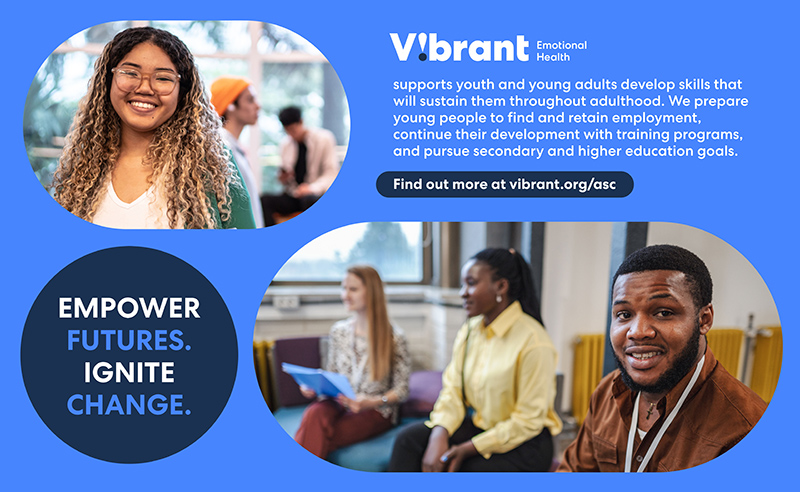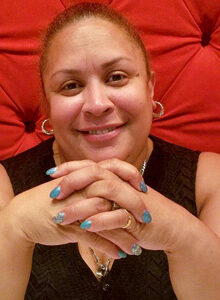Imagine sitting in a classroom, expected to absorb the curriculum, when you are extremely worried about whether your family will be evicted from their home. What can you, a young person trying to graduate from high school, do to change your circumstances? What if you have also survived traumatic experiences and are working on your recovery from a mental health challenge? Chances are, as a youth, you will be disconnected and unable to see past the barriers and the stressors to be able to prepare for adulthood, learn, and grow to your full potential.

Many assume that once youth living with mental health challenges receive treatment, they should be able to complete middle and high school solely with the educational resources provided. Our experience preparing youth in Vibrant Emotional Health’s three Adolescent Skills Center (ASC) programs has demonstrated that this is not always the case. The youth we serve often report that traditional school settings were the worst possible places for them to be when attempting to manage their feelings of sadness, dread, hopelessness, fear, racing thoughts, and anger. This environment can trigger or worsen all those feelings because students are expected to perform at a level beyond what they have been prepared to achieve, leading to increased stress and anxiety.
It is not necessarily the engagement with education that causes such feelings, but rather the expectation that academics are all they need to focus on when life suddenly gets in the way of the expectation. These feelings and behaviors interfere with their academic success, including obtaining and maintaining youth employment.
In the words of a youth we were fortunate to work with, “Don’t stress me with facts about history or essays; teach me how to live, how to manage my life!” This student’s plea highlights the real-life consequences of living with mental health challenges while also struggling with environmental stressors that interfere with youth’s educational success and their ability to prepare for steady employment and, ultimately, prevent homelessness.
For New York City youth struggling with unmet mental health challenges who have not been successful in traditional educational settings and who are at risk of not completing their education or developing marketable job skills, there are ASCs available to help. Vibrant operates ASC programs in the Bronx, Queens, and Manhattan. These programs prepare youth aged 16-22 and offer a comprehensive vocational and educational program with a unique focus on mental health support. The youth entering ASC programs have typically been unable to succeed academically, nor have they been able to manage their mental health challenges. The ASCs prepare youth to participate in GED preparation, vocational assessment and evaluation, vocational and educational remediation, and social-emotional support services.
The ASCs also provide lessons on critical life skills, such as time management and conflict resolution. Specialized groups are offered so youth can obtain support from their peers and trained staff. They teach money management and other skills using group simulation activities to prepare them for real-life experiences. These include engaging in an apartment search, completing the eligibility checker to see if they qualify for government assistance programs, calculating expenses, and exploring employment programs. The ASC staff assist with referrals to external vocational resources such as Access VR, which provides training that leads to employment, while also providing work experience support by placing youth in paid internships. In addition, they aid homeless youth by navigating housing programs and the shelter system while helping them obtain medical insurance and other needed support. This gives the youth an understanding of the workplace and a space to test the skills they are learning at the ASCs. The support the ASCs provide can be central to prepare youth to avoid homelessness and gain the skills and experience they need to ensure they can obtain and maintain housing in the future.
For example, Nadia* entered the Adolescent Skills program at 16. She and her family have lived in and out of shelters since she was six. Nadia had been diagnosed with depression and learning and behavioral disabilities and had a long history of being bullied in school from an early age. She had only obtained seven high school credits at the time of her enrollment. Nadia was enrolled in the GED and vocational programs, where she was scheduled to attend five days a week. But Nadia struggled with her attendance. She often told her case manager she did not have anything to eat or wear and that she struggled to manage angry feelings that caused her to lose sleep most nights.
Nadia’s case manager helped her develop a strategy to help her participate in the program more easily. At first, Nadia attended the program gradually, beginning with only two times per week. Over time, she increased her attendance in the educational program and then moved into an internship working with children at an afterschool program. Nadia obtained her GED diploma at seventeen, applied to college, and graduated with her associate’s degree. She began to ask herself what was next, which had never been a question that had entered her mind. Upon graduation, it dawned on Nadia that she didn’t know what to do next, and she realized she had never thought she would get this far with her education. She met with several ASC staff and asked them for guidance about her next steps. She told the ASC staff that she had lived most of her life in homeless shelters and had never before thought she could obtain gainful employment or housing for herself. After exploring her interests and life goals with the ASC team, Nadia applied to John Jay College to continue her education and pursue a bachelor’s degree. She is studying full-time and working to gain continued job experience; she and her family are now living in permanent housing.
Nadia’s success story demonstrates that with appropriate support in place, youth living with mental health and educational challenges can meet their life goals, including obtaining and maintaining housing. However, to continue preparing youth struggling with mental illness and learning and behavioral disorders, more support is needed to ensure they can obtain and maintain housing. These include, but are not limited to:
- Increased units of low-income housing accessible to youth, young adults, and their families;
- More programs that provide alternate pathways to achieving a high school equivalency while also addressing youth mental health needs;
- The proliferation of life skills and vocational training in traditional educational settings;
- Increased number of early intervention programs to identify and address burgeoning mental health or learning challenges among elementary and middle school students; and
- More shelter programs available to youth living with mental health challenges.
Recovery, as we know in our sector, is possible. We also know that recovery is difficult, if not impossible, to achieve fully without adequate housing. Youth living with mental health challenges deserve to receive the care and support they need to thrive emotionally, educationally, and vocationally; we owe it to them to improve our systems so that they can blossom.
Note: *Not the student’s real name
Jacqueline Brown is Senior Director and Lisa Furst is Chief Program Officer at Vibrant Emotional Health.






